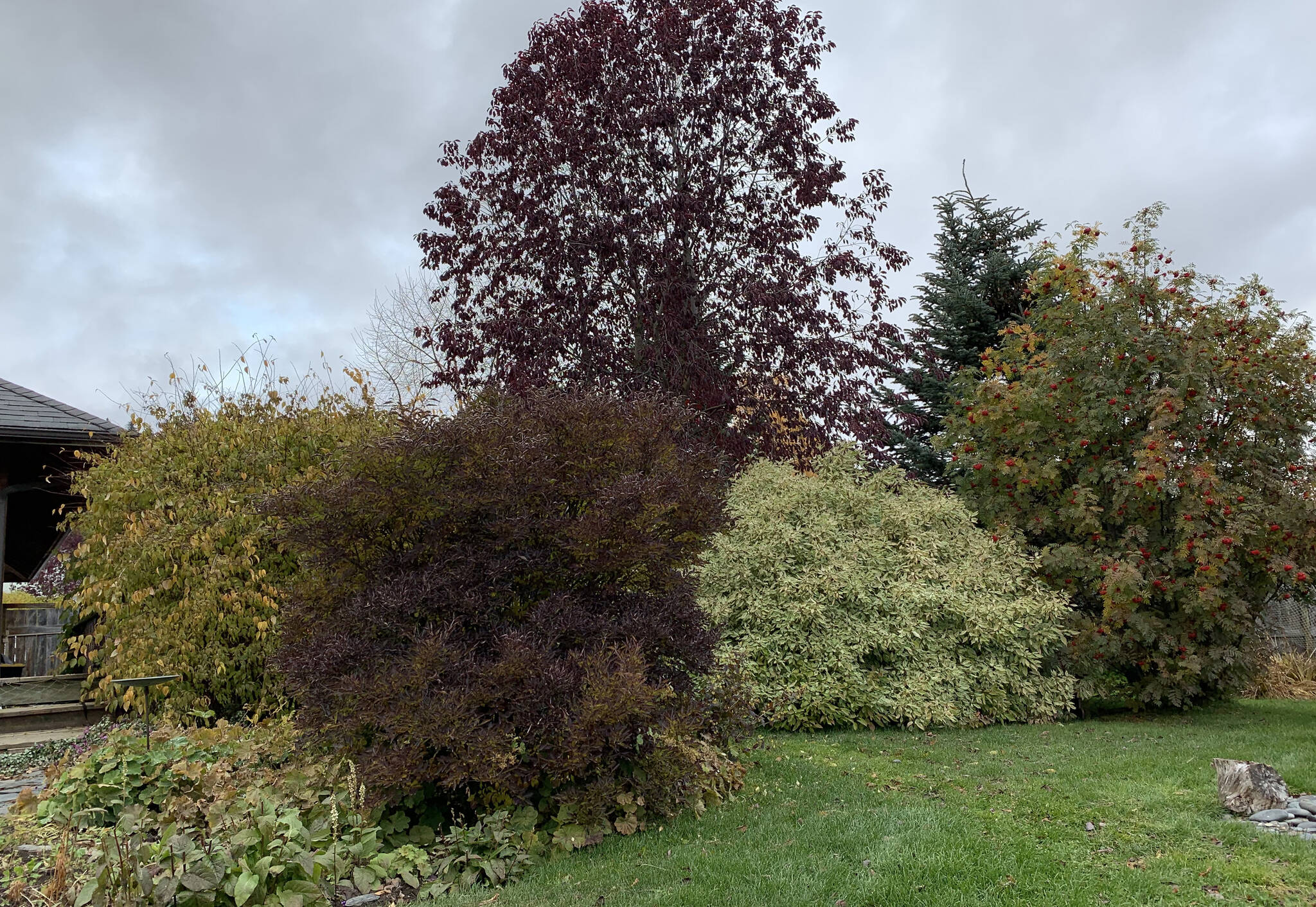I don’t know anyone who doesn’t love fall. The colors are spectacular and the more you have in your immediate surroundings the better. I covet my neighbor Karen’s cotoneaster. During the growing season ,it is the most nondescript, actually boring shrub to be endured, but come fall, it bursts into glory, all bright red leaves and black berries. Stunning.
Pioneer Avenue may be a street that you use day in and day out, but have you noticed the Amur maples? Last year a misguided soul pruned them into squares — such a misfortune. But this year they have been left to their natural inclination which is to arch, much like a mock orange. The leaves have more going for them then the cotoneaster during the growing season; they at least have an interesting shape. Then, come fall, they turn a stunning red/gold. There must be a name for this color, but it’s much too late at night to make any phone calls to my artist friends.
I recently have been asked to offer suggestions of plant combinations for fall color. Nope, that would fall into the “designing the garden” category which, if you read this column with any regularity, you’ll know that I’m no planner. But, really, what is there to plan? The colors in this little plot are all working together no matter what. They are plants after all, and they don’t argue with each other.
The natural environs are all singing the same song, all on the same page, all complimenting each other. Combining these colors — various shades of gold, red/gold, a little straight up red with the back drop of deep green spruce — fall is a wondrous season.
This little street has a wealth of mountain ash trees and they tend to change color at different times. I have the pleasure of looking across the street and seeing the neighboring trees in full fall regalia, berries and all, while mine are still green, waiting their turn to step onto the stage. Up and down the street, each tree taking its turn, really, it’s a pleasure to check the mail.
So plant what you want where you want it, they will all take care of themselves and each other. We humans should take note.
We like to walk through the woods in front of the house as an alternate route to the high school cross country running trails when we need to get Jade the Dog out for a bit of a stroll. Watching my feet while maneuvering roots and dead fall, I noticed a little tiny pile of fresh wood chips at the base of a dead birch. Looking up I was delighted to find three cavities that nuthatches or chickadees had made. Although I looked up both species in “The Sibley Guide to Bird Life & Behavior,” there didn’t seem to be anything definitive about how they make their cavities. Are all three occupied? Year round? I am, once again, a failed birder. Nevertheless, what a delight to find them, and all I had to do was take a walk in the forest directly in front of the house.
Right here on our little piece of Alaska we have some interesting blooming going on. This has been such a challenging year that it is no wonder that some of these introduced plants are out of sync. There are still blooms on the James McFarland lilac, very tiny but pink as can be, and offering a touch of loveliness in a very overgrown mass of lilacs. The Desante delphinium that I started from seed this spring is holding on to a few blooms, looking a bit worse for wear but in evidence. The clematis alpina, which blooms early spring, has a couple dozen nodding blue flowers. The armeria (of which there are several here and there) is still popping off pink delights and the trusty dianthus Arctic Fire blooms like there is no winter in its future. This wouldn’t be complete if I didn’t mention the lone foxglove, undaunted, blooming. I wish it well.
Moving to the vegetable plot, I am doubting myself. I don’t usually mulch the garlic, and just throw the Christmas boughs on it. But this year I’ve loaded some straw on it, and the image I have in my dreams are of rodents making a cozy home in all that straw. I don’t have a crystal ball and can’t predict if we are going to have an ice event like last year, but that’s what I’m trying to bet against. There’s a strong urge that I’m fighting to pull that straw off. We’ll see.
Speaking of garlic, I’m using the remaining four heads from last year’s harvest. That’s the beauty of Inchelium Red, it stores really well. No, there is no snap when I bash the cloves with the flat side of the knife, but still, it’s garlic. I’m ready to clean up this year’s harvest and bring it upstairs along with the shallots. The onions are struggling. They didn’t have long enough in the ground to mature. I’ll need to use them fast.
John spread compost on the raised beds and I took the opportunity to use every last bit of the crushed egg shells between the soil and the boards that frame the beds. Methinks this will slow down the slug invasion come spring.
If you brought in herbs from outdoors to line up on your windowsill, be sure to check them for aphids. You really don’t want to introduce aphids to your house plants.
Clean, oil, sharpen your tools. You want them to be ready when you need them.
Rosemary Fitzpatrick is a longtime Homer gardener and has been writing Kachemak Gardener since 1990.


